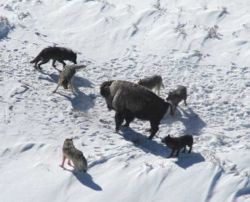Carnivore
2007 Schools Wikipedia Selection. Related subjects: General Biology

A carnivore ( IPA: ['kɑ(r)nivɔ(r)]), meaning 'meat eater' (Latin carne meaning 'flesh' and vorare meaning 'to devour'), is an animal that eats a diet consisting mainly of meat, whether it comes from live animals or dead ones ( scavenging). Some animals are considered carnivores even if their diets contain very little meat (e.g., predatory arthropods such as spiders or mantids that may rarely consume small vertebrate prey). Animals that subsist on a diet consisting only of meat are referred to as obligate carnivores.
The word also refers to the mammals of the Order Carnivora, many (but not all) of which fit the first definition. Bears are an example of members of Carnivora that are not true carnivores. Carnivores that eat insects primarily or exclusively are called insectivores, while those that eat fish primarily or exclusively are called piscivores.
There are also several species of carnivorous plants, though most are primarily insectivorous.
The theropod dinosaurs such as Tyrannosaurus rex were mostly obligate carnivores, while sauropod and ornithischian dinosaurs were mostly herbivorous.
Characteristics of carnivores
Characteristics commonly 'associated' with carnivores include organs for capturing and disarticulating prey (teeth and claws serve these functions in many vertebrates) and status as a hunter. In truth, these assumptions may be misleading, as some carnivores do not hunt and are scavengers (though most hunting carnivores will scavenge when the opportunity exists). Thus they do not have the characteristics associated with hunting carnivores.
Obligate carnivores
An obligate or true carnivore is an animal that subsists on a diet consisting only of meat. They may consume other products presented to them, especially animal products like cheese and bone marrow or sweet sugary substances like honey and syrup but, as these items are not essential, they do not consume these on a regular basis. True carnivores lack the physiology required for the efficient digestion of vegetable matter and, in fact, some carnivorous mammals eat vegetation specifically as an emetic.
Plant material
In most cases, some plant material is essential for adequate nutrition, particularly with regard to minerals, vitamins and fibre. Most wild carnivores consume this in the digestive system of their prey. Many carnivores also eat herbivore dung, presumably to obtain essential nutrients that they could not otherwise obtain, since their dentition and digestive system do not permit efficient processing of vegetable matter.
As food
Carnivores are forbidden to be eaten according to Islamic dietary laws.
List of carnivores

- Felines, ranging from domestic cats to lions, tigers, and other large predators.
- Some canines, such the Gray Wolf but not the Red Wolf or coyote. Domestic dogs are broadly considered carnivorous but the classification is often debated.
- Hyenas
- Some mustelids, including ferrets
- Polar Bears
- Pinnipeds ( seals, sea lions, walruses, etc.)
- Birds of prey, including hawks, eagles, falcons and owls
- Scavenger birds, like vultures
- Several species of waterfowl including gulls, penguins, pelicans, storks, and herons
- Anurans (frogs and toads)
- Snakes
- Some lizards, such as the Gila Monster
- Crocodilians
- Sharks and many other species of fish
- Toothed whales
- Octopuses and squid
- Spiders, scorpions, and many other arachnids
- Mantids, Giant water bugs, and many other insects
- Cnidarians
- Carnivorous Marsupials
